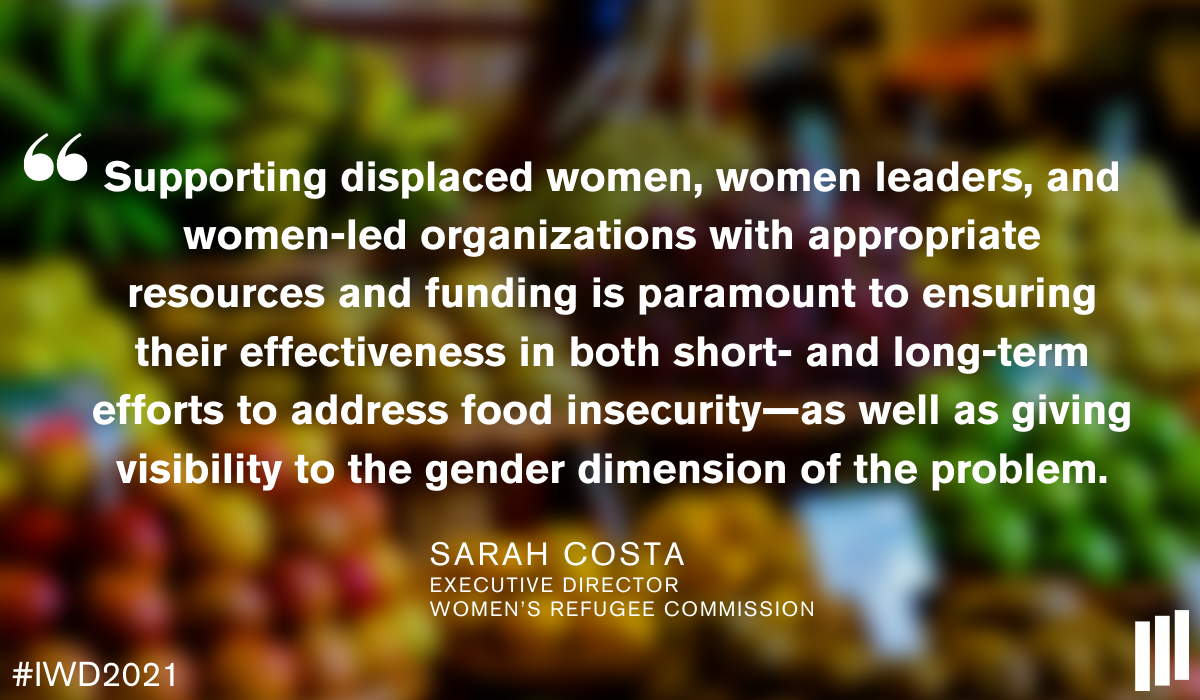
This post was originally posted in Ms. Magazine.
COVID-19 has exposed and exacerbated the deep disparities in accessing resources worldwide, especially in conflict and crisis settings. But there are solutions, and women must be part of them.
As the world marks International Women’s Day on Monday, and the U.N. prepares to debate conflict and hunger later in the week, it imperative that world leaders—and the humanitarian community—embrace the leadership of displaced women and girls at this pivotal moment.
COVID-19 has exposed and exacerbated the deep disparities in accessing resources worldwide, especially in conflict and crisis settings. A report by the World Food Programme (WFP) last year showed that access to food is grossly unequal around the world.
COVID-19 adds another layer to the challenges and burdens faced by those most at risk—particularly refugee women and girls—through increased job losses, dislocation of basic health and education services, growing burden of care, and rising rates of gender-based violence in already fragile economies. But there are solutions, and women must be part of them.
At the beginning of the pandemic, the Women’s Refugee Commission reached out to local partners to learn how the pandemic was affecting their communities and how they were responding. Our partners in Uganda, South Sudan and Afghanistan confirmed that food insecurity was among their top concerns—ahead of heath care and access to sanitizer or masks. In the words of a widow raising five children in Kabul: “We know what COVID-19 is, but we don’t know how to feed our children.”
The pivotal role women and girls play in ensuring a household’s food security is well documented. And yet, they still have limited access to services, decision-making spaces, and the necessary resources to tackle their own food insecurity and that of their families.
The fact is that food insecurity has a highly gendered impact. Women and girls have a higher probability of being food insecure than men and experience different needs and risks. For example, malnourished women are more likely to have complications when giving birth and are at greater risk of contracting diseases.
Their children are at risk, too, with severe malnutrition a major cause of death for children under five.
Also, women are already burdened with an unequal and unpaid gender division of labor, which will likely increase when food insecurity occurs. Women make up almost half of agricultural employment, but face greater constraints than their male counterparts in accessing resources, including financial resources. And women and girls often bear the primary responsibility for the food security and preparation for their families, forcing them to make difficult trade-offs when faced with shortages.
Rising food prices or loss of income means that women and girls might turn to negative coping strategies, such as reducing their own nutrition to feed family members, being forced into early marriage, or taking on risky jobs such as survival sex—all while generally facing higher risks of gender-based violence.
The importance of including local women’s organizations and women’s leadership in relief and recovery cannot be overstated. They have a wider reach to affected populations and hold the trust of their communities. Currently, for example, they are providing basic services and are helping to distribute cash assistance to displaced women affected by the COVID-19 pandemic.
Cash and voucher assistance (CVA) is an example of a good practice to draw from and build upon to help women become food secure. Increasingly, CVA has been replacing other forms of aid, including in-kind assistance such as food, blankets, and shelter, where markets are functional. As of 2019, 18 percent of humanitarian assistance globally was delivered via CVA. The benefits of CVA include boosting local economies and providing affected populations with the ability to make their own decisions.
While the use of cash itself is not inherently risky, simply designing cash programs without a gender lens can be. Our research shows that if designed and distributed inclusively—with women at the center of the decision-making process—CVA can be a key tool to help families afford food and enhance their safety, including protection from the increased risk of gender-based violence in crisis settings. Helping to address the financial constraints of the household, with input from women, cash can increase women’s and girls’ access to food, including within their own family.
Supporting displaced women, women leaders and women-led organizations with appropriate resources and funding is paramount to ensuring their effectiveness in both short- and long-term efforts to address food insecurity—as well as giving visibility to the gender dimension of the problem.
In crisis-affected settings, food scarcity becomes a magnifying glass to existing inequalities. Women and girls with disabilities, for example, already face multiple layers of exclusion and discrimination. Reduced economic opportunities and food shortages hit them even harder, given barriers to mobility and lack of accessible information and services targeted to their needs. Discrimination and lack of access to resources also hold true for gender-nonconforming people who are often specifically targeted for defying gender norms.
Ending food insecurity requires us to understand that gender inequality is a major contributing factor. Deconstructing the barriers to women’s ability to respond to crises and increasing their access to and control over resources is critical to attaining food security. Women and girls must take part in the decisions about and the design of solutions for the challenges that impact their lives and the lives of their communities.
They are the leaders, innovators, farmers and caretakers who can help solve this problem. It’s time to listen to the women who are already leading the way and understand the value of holistic, inclusive approaches to ending food insecurity and building the bridge to longer-term, sustainable development practices.
We need more women at the table if we are to build back more inclusively and equitably—during and after COVID.

